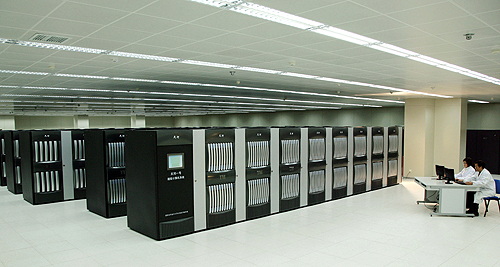|
 |
|
GIANT INSTRUMENT: In October, China unveiled its fastest supercomputer, which is theoretically capable of processing more than 1 quadrillion calculations per second | In September 2008, China produced a supercomputer that could complete 100 trillion operations every second. A year later, Tianhe-1, China's first petaflop computer, was clocked at a speed of 1.206 quadrillion operations per second. Tianhe-1 ranks fifth on the latest list of the world's Top 500 supercomputers, making China the second country in the world able to produce such a powerful instrument.
Before the new list came out, China's highest ranking had been 10th place.
Germany's University of Mannheim and the U.S. National Energy Research Scientific Computing Center, the Lawrence Berkeley National Laboratory and the University of Tennessee compile the list twice a year.
How fast?
With peak performance reaching 1.206 quadrillion operations per second, Tianhe-1 can make the same number of calculations in an hour that it would take the sum of all Chinese people's whole life to do. A single day of work for Tianhe-1 involves the same amount of processing that it would take a mainstream dual-core personal computer 160 years to complete.
Tianhe-1 is also capable of saving all 27 million books in the National Library of China four times over. The 155-ton system is housed in 103 refrigerator-like cabinets that are lined up in an area of about 1,000 square meters.
The Tianhe project, which is expected to become one of China's major engines for hi-tech development, started in 2008 with the investment of about 600 million yuan ($88 million) by the National University of Defense Technology (NUDT). It was built in north China's port city of Tianjin. More than 200 people work on the supercomputing team.
"I was astonished at the successful development of Tianhe-1," said Zhang Yunquan, a researcher with the Institute of Software at the Chinese Academy of Sciences (CAS). "I previously forecast China's first petaflop computer would come out no earlier than the end of 2010. This is a milestone in China's computer development history."
Dou Wenhua, an NUDT professor, said that Tianhe-1 coming on line means scientific studies would speed up.
It has long been the subject of debate whether the central processing unit (CPU) would be replaced by a graphic processing unit (GPU) in computers or whether the two technologies would be combined. Tianhe-1 is a combination of the two technologies with 6,144 CPUs and 5,120 GPUs.
"The GPU is generally used to read graphics and videos. Can it also be used in calculating? Some people think it can, but actually it doesn't work very well. After combining it with a CPU, the calculating abilities of the GPU increased from 20 percent to 70 percent," said Zhang Yulin, President of NUDT. "With Tianhe-1 we've paved a new way for computer technology and made something theoretically impossible possible."
"As far as I know, a combination of CPUs and GPUs is something new to make a petaflop computer. A GPU plays a role as an accelerator to make the computer run faster, but reduces its power consumption and cost," Zhang said.
The Tianhe project was achieved with the help of Binhai New Area, a fast-growing economic development zone in Tianjin. "The support of the local government is very important for the success of this project," said Zhang.
Everyday application
Many regard supercomputers as an academic or government pursuit and not very close to the everyday lives of common people. "Actually, super computers have already been involved in many fields of our lives," said Zhou Xingming, a CAS academician and an NUDT professor.
"With supercomputers, forecasts of the weather at a specific time within a small area can be more accurate," said Zhang. "For example, we used to be able only to forecast the weather for a district of Beijing, but now we can tell what the weather will be at the campus of a university in that district."
Some natural resources such as oil and natural gas also need the help of supercomputers to be discovered. Tianhe-1's first major task is to help in the search for oil and other natural resources. It will also be used to process satellite remote-sensing and environmental data as well as to analyze financial data.
Researcher Li Nan said making animated movies is another task to which supercomputers can contribute. High-performance desktop computers have already shortened production time of an animated movie from several years to several months, but supercomputers would be able to shorten that time to just several minutes. There are 5,120 video cards in Tianhe-1 and its processing speed is 20,000 times that of desktop computers. | 